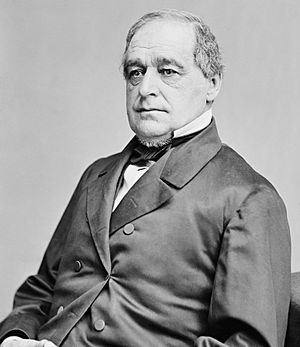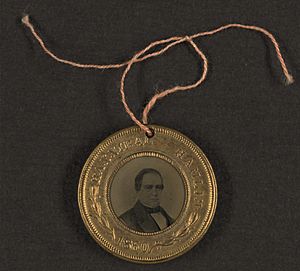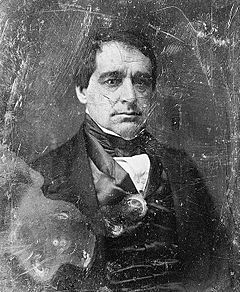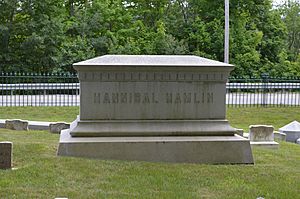Hannibal Hamlin facts for kids
Quick facts for kids
Hannibal Hamlin
|
|
|---|---|

Photograph by Mathew Brady, c. 1860–1865
|
|
| 15th Vice President of the United States | |
| In office March 4, 1861 – March 4, 1865 |
|
| President | Abraham Lincoln |
| Preceded by | John C. Breckinridge |
| Succeeded by | Andrew Johnson |
| United States Minister to Spain | |
| In office December 20, 1881 – October 17, 1882 |
|
| President | Chester A. Arthur |
| Preceded by | Lucius Fairchild |
| Succeeded by | John W. Foster |
| United States Senator from Maine |
|
| In office March 4, 1869 – March 3, 1881 |
|
| Preceded by | Lot M. Morrill |
| Succeeded by | Eugene Hale |
| In office March 4, 1857 – January 17, 1861 |
|
| Preceded by | Amos Nourse |
| Succeeded by | Lot M. Morrill |
| In office June 8, 1848 – January 7, 1857 |
|
| Preceded by | Wyman B. S. Moor |
| Succeeded by | Amos Nourse |
| 26th Governor of Maine | |
| In office January 8, 1857 – February 25, 1857 |
|
| Preceded by | Samuel Wells |
| Succeeded by | Joseph H. Williams |
| Member of the U.S. House of Representatives from Maine's 6th district |
|
| In office March 4, 1843 – March 3, 1847 |
|
| Preceded by | Alfred Marshall |
| Succeeded by | James S. Wiley |
| Personal details | |
| Born | August 27, 1809 Paris, Massachusetts, U.S. (now Maine, U.S.) |
| Died | July 4, 1891 (aged 81) Bangor, Maine, U.S. |
| Resting place | Mount Hope Cemetery, Bangor, Maine, U.S. |
| Political party | Democratic (before 1856) Republican (1856–1891) |
| Spouses |
Sarah Emery
(m. 1833; died 1855)Ellen Emery
(m. 1856) |
| Children | 6, including Charles, Cyrus, and Hannibal |
| Signature | |
Hannibal Hamlin (born August 27, 1809 – died July 4, 1891) was an American lawyer and politician. He served as the 15th Vice President of the United States from 1861 to 1865. This was during Abraham Lincoln's first term as president. Hamlin was the very first Republican vice president.
Hamlin started his political journey as a Democrat in the Maine House of Representatives. He was then elected to the United States House of Representatives twice. Later, he became a U.S. Senator. He strongly believed in ending slavery. Because of this, he left the Democratic Party in 1856 and joined the new Republican Party.
In the 1860 election, Hamlin was chosen as Lincoln's running mate. Lincoln was from the Midwest (Illinois), so having Hamlin from New England (Maine) helped balance the ticket. Even though he and Lincoln were not close friends, Hamlin strongly supported Lincoln's big projects. One important project was the Emancipation Proclamation, which freed enslaved people.
For the 1864 election, Hamlin was replaced as vice president. Andrew Johnson, a Democrat from the South, became Lincoln's new running mate. This was done to attract Southern voters who supported the Union. After his vice presidency, Hamlin worked as a customs collector. He was then elected to the Senate two more times. Finally, he served as the United States Ambassador to Spain before he retired in 1882.
Contents
Early Life and Education
Hannibal Hamlin was born in Paris, Maine, on August 27, 1809. At that time, Paris was part of Massachusetts. His parents were Cyrus and Anna Hamlin. His family had been in America since the 1600s.
An old story says that a Native American medicine woman named Molly Ockett saved Hamlin's life as a baby. He was very sick, and she told his parents to give him warm cow's milk. He soon got better.
Hamlin went to local schools and Hebron Academy. He also helped manage his father's farm. For a few years, he helped publish a newspaper called the Oxford Jeffersonian. He later studied law and became a lawyer in 1833. He practiced law in Hampden, Maine, until 1848.
Family Life
Hamlin married Sarah Jane Emery in 1833. Her father, Stephen Emery, was the Attorney General of Maine. Hamlin and Sarah had four children: George, Charles, Cyrus, and Sarah.
Sadly, Sarah died in 1855. The next year, Hamlin married Sarah's half-sister, Ellen Vesta Emery. They had two more children, Hannibal E. and Frank. Ellen Hamlin lived until 1925.
Starting in Politics
Hamlin's political career began in 1835. He was elected to the Maine House of Representatives. He also served in the militia as a Major. He helped calm tensions during the Aroostook War in 1839. This war was a bloodless conflict over the border between Maine and Canada.
Hamlin ran for the U.S. House of Representatives in 1840 but did not win. He left the State House in 1841. Later, he was elected to the United States House of Representatives for two terms, from 1843 to 1847. In 1848, the state legislature chose him to fill a spot in the United States Senate. He was elected for a full Senate term in 1851.
At first, Hamlin was a Democrat. He supported Franklin Pierce for president in 1852.
Standing Against Slavery
From the start of his time in Congress, Hamlin was known for opposing the spread of slavery. He strongly supported the Wilmot Proviso. This was a plan to ban slavery in new territories gained from the Mexican-American War. He also spoke out against the Compromise of 1850. This compromise allowed some new territories to decide for themselves if they would allow slavery.
In 1854, Hamlin strongly opposed the Kansas–Nebraska Act. This law canceled the Missouri Compromise, which had limited where slavery could spread. When the Democratic Party supported this new law, Hamlin decided to leave the party. On June 12, 1856, he joined the new Republican Party. This was a big deal across the country.
The Republicans then chose Hamlin to run for governor of Maine that same year. He won by a lot and became governor on January 8, 1857. However, he resigned from being governor in February 1857. He went back to the United States Senate, where he served until January 1861.
Vice President (1861–1865)

The Republican Party chose Hamlin to be Vice President of the United States in the 1860 presidential election. He ran with Abraham Lincoln. Since Lincoln was from Illinois, having Hamlin from Maine helped get votes from different parts of the country. As a former Democrat, Hamlin also helped convince other anti-slavery Democrats to join the Republican Party.
Hamlin and Lincoln were not close friends, but they worked well together. At that time, the vice president mostly worked with the Senate and did not attend cabinet meetings. Hamlin did not visit the White House very often.
Hamlin had little power in Lincoln's government. However, he strongly pushed for the Emancipation Proclamation. This important document declared enslaved people free. He also urged that Black Americans be allowed to join the army.
In the summer of 1864, Hamlin served in the Maine State Guard, a local military unit. Even though he was vice president, he chose to serve. He wanted to show that everyone should do their part. He worked as a company cook for a while and was promoted to corporal.
In June 1864, the Republicans and some Democrats who supported the war formed the National Union Party. Lincoln was chosen to run again. But Andrew Johnson, a Democrat from Tennessee, replaced Hamlin as Lincoln's running mate. Lincoln wanted to get more support, especially from the South. Johnson was good at helping rebuild areas in the South during the war. Hamlin, on the other hand, was close to the "Radical Republicans" who later disagreed with Johnson. Lincoln and Johnson won the election in November 1864. Hamlin's term as vice president ended on March 4, 1865.
After leaving the vice presidency, Hamlin briefly worked as a customs collector in Boston. He quit this job because he disagreed with President Johnson's plans for rebuilding the South after the war.
After the Vice Presidency (1865–1891)
Hamlin did not want to stop working in public service. He returned to the United States Senate in 1869. He served two more terms. He decided not to run for reelection in 1880 because of heart problems. His last public job was in 1881. He became the United States Ambassador to Spain. He held this job until October 17, 1882.
After returning from Spain, Hamlin retired. He moved back to his home in Bangor, Maine, which he bought in 1851. This house, called the Hannibal Hamlin House, is now a historic landmark. It is listed on the National Register of Historic Places.
Hamlin was also recognized for his service during the Civil War. He became a member of the Military Order of the Loyal Legion of the United States. This group honored civilians who greatly helped the Union during the war.
Death
On July 4, 1891, Hannibal Hamlin was playing cards at a club in Bangor. He suddenly collapsed and died a few hours later. He was 81 years old. He is buried in the Hamlin family plot at Mount Hope Cemetery in Bangor. He lived longer than six of the vice presidents who came after him.
Family and Legacy
Hamlin had four sons who grew up: Charles, Cyrus, Hannibal Emery, and Frank. Charles and Cyrus fought for the Union in the Civil War. Both became generals. Cyrus was one of the first Union officers to suggest that Black soldiers should join the army. Charles and his sister Sarah were at Ford's Theater the night Lincoln was assassinated. Hannibal Emery Hamlin later became the Attorney General of Maine.
Hamlin's older brother, Elijah Livermore Hamlin, was also involved in public life. He was mayor of Bangor for a time. Hannibal's nephew, Augustus Choate Hamlin, was a doctor and a historian. He served as a surgeon in the Civil War.
Hannibal's cousin, Cyrus Hamlin, became a missionary in Turkey. He founded Robert College there. He later became president of Middlebury College in Vermont.
Honors and Recognition

Many places are named after Hannibal Hamlin. These include Hamlin County, South Dakota; towns like Hamlin, Kansas, Hamlin, New York, and Hamlin, West Virginia; and Hamlin Lake in Michigan. There is also Hamlin Peak, a mountain in Maine. A small village in Maine, Hamlin, Maine, is a border crossing with Canada.
You can find statues of Hamlin in the United States Capitol and in a public park in Bangor, Maine. A building on the University of Maine campus in Orono, Maine, is named Hannibal Hamlin Hall. The Hannibal Hamlin Memorial Library is next to his birthplace in Paris, Maine.
Hamlin's first law office has been restored and is on display at the Hampden Maine Historical Society. His home in Bangor, Maine, is also a historic site. Hamlin Park in Chicago is named in his honor.
See also
 In Spanish: Hannibal Hamlin para niños
In Spanish: Hannibal Hamlin para niños
- List of American politicians who switched parties in office
- Statue of Hannibal Hamlin



